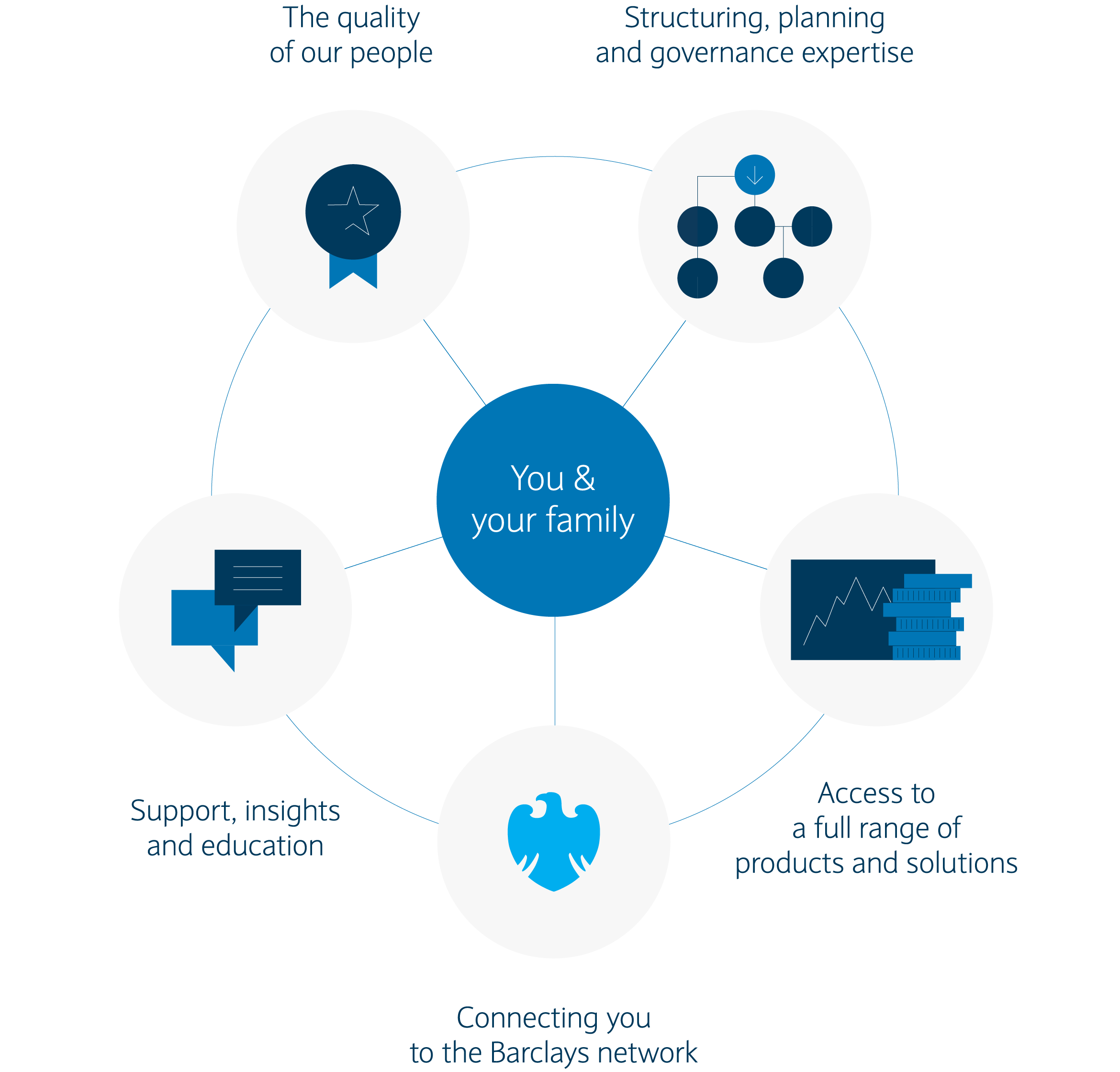
Smarter Succession
Discover our Smarter Succession content series which uncovers some of the tensions surrounding wealth and business transfer, and how to overcome them.

02 November 2020
10 minute read
Harmonious wealth transfer has become more difficult as intergenerational differences fuel a rise in family conflicts. But could a family charter be the key to successfully transferring wealth across generations?
The Oracle of Omaha himself, Warren Buffett, realised early on he needed to leave his children “enough money so that they feel they could do anything, but not so much that they could do nothing”.
However, achieving a single vision for wealth transfer across generations is not easy.
In the next decade, a digitally native, highly-travelled and more environmentally and socially conscious generation is set to inherit a sum greater than China’s annual GDP1.
As their passions, interests and values diverge from that of their parents', a sense of mistrust between generations can emerge when it comes to managing family wealth.
Our research, commissioned from leading intelligence agency, Savanta, shows more than half of wealth originators are concerned about the next generation’s ability to manage money and investments, given their global mindset and differing ambitions. Perhaps unsurprisingly, four in ten (39%) from the older generations believe there should be a single decision maker in the family, compared to 19% of millennials2. These views are fuelling discord and creating barriers to successful wealth transfer.

Source: Smarter Succession: The Challenges and Opportunities of Intergenerational Wealth Transfer, Barclays Private Bank, October 2020
To avoid potential conflicts and the inevitable dispersion of wealth that can accompany them, families are invoking the power of a family charter to help their wealth endure the test of time.
Sometimes referred to as a family constitution, this formal document aims to set out a core vision for a family’s business interests; responsibilities for family members; and criteria to guide future business decisions.
Separate from a legal will, a family charter is in many ways a more important asset. It addresses the often ignored, complex emotional components of succession planning, such as the struggle of wealth generators to give up control of their money, or trust young inheritors with ambitions to take a business in a new direction.
For many, it brings the often avoided subject of money and succession planning to the fore, and provides inheritors with a value-led framework in which to operate – one, ten or fifty years in the future.
Clare Stirzaker, Solicitor and Family Governance Specialist at PwC, says: “One of the biggest benefits of using a charter is the fact families have to start communicating on topics they have never spoken about before. It sets out very clearly what people can expect from each other. That process can be incredibly valuable.”
One of the biggest benefits of using a charter is the fact families have to start communicating on topics they have never spoken about before.
Solicitor and Family Governance Specialist at PwC
A popular misconception during the development of a family charter is that you engage solely with the main shareholder or owner of the business. In reality, to provide good advice it is crucial to look at all of the different interests within a family business unit and ensure their views are considered rather than ignored, explains Stirzaker. This notion is backed by behavioural principles which suggest the more effort an individual has invested in creating something, the more they tend to value it versus something prepared by others.
For one Barclays Private Bank client, the family charter seemed to be a natural extension of how business decisions were communicated between the family before the business was sold.
He explains: “We understood it was not worth selling the business if we didn’t know what to do with the money. So we held a family meeting, having sold the previous year, and wrote a set of family rules where we recorded how we would work together and build a balanced investment portfolio for our wealth. It allowed us to create a trust and a protector committee that ensured a succession plan for future generations.”
The rules included notes on charitable gifts, as well as the need for quarterly family meetings held alongside advisers, accountants and tax professionals, who advise the family and oversee decisions. However, the real benefit of this structure was not about how his children should manage the money per se, but ensuring it couldn’t be split between individual families in the future – a key objective of the wealth generator’s wishes.
“We all created the rules and everyone, myself included, knows to abide by them. If our portfolio is knocked off-course, as a result of something like coronavirus, for example, we know exactly what to do because we have a plan- that has been agreed in the family rules. As in business, it brings clarity to the [wealth management] process.”
Such transparency and ensuring the buy-in of everybody in the family unit on important decisions is, according to Mark Tucker, Global Head of Wealth Advisory at Barclays Private Bank, at the heart of family charter success.
“Family charters and family constitutions are important but in many instances the content is not the most important aspect, especially if not legally binding,” he explains. “Drafting such a governance framework should be viewed as a success because it's an acknowledgment that the family has communicated effectively and appreciate the value of establishing a framework for the future running of the family business.”
Alexander Joshi, Behavioural Finance Specialist at Barclays Private Bank, agrees. He believes having a pre-agreed formal structure in place reduces the impact of biases and emotions on a range of important decisions. “It is similar to a board of directors in a company. Essentially what you are trying to do is create a checks and balances system. As well as a charter being useful for the family to vocalise what it wants to achieve, they can refer back to it in times of need, stress or crisis to ensure the family is staying on track.”
But the importance of a family charter also goes beyond defining collective values or installing good governance.
By inviting multiple generations to participate in discussions about money, it encourages patriarchs or matriarchs to keep an open mind about their future goals. For some, this clarity allows them to better understand their parents’, children’s or grandchildren’s viewpoints.
For example, our research shows younger wealth inheritors’ aims to grow a business are often at odds with a parent’s wish to preserve it. Only a third of millennials (38%) feel their family understands their aims, and half (50%) believe they are not respected for them2.
Meanwhile, wealth originators are worried about how a future generation will continue their legacy and fear they will take on greater amounts of risk. This drives their strong desire to hold on to their wealth for as long as possible.
Joshi argues such views are completely natural, given the different stages of life that wealth generators and inheritors are at. It makes good financial sense to learn about risks and opportunities from a younger generation as it encourages diversity of thought: “You would never give a 65-year-old the same asset allocation as a 25-year-old. All things being equal, a younger investor can take on more risk as they have a much longer time horizon to consider.”

Source: Smarter Succession: The Challenges and Opportunities of Intergenerational Wealth Transfer, Barclays Private Bank, October 2020
If used from an early stage, a family charter can help younger generations understand how to use their wealth. This is particularly the case if, for example, they are introduced to the notion of philanthropy through clearly defined principles in a charter.
Emma Turner, Director of Philanthropy Service at Barclays Private Bank, explains: “Our Future Giving initiative aims to involve children as young as five in the giving process by allowing them to control a small or large amount of money. Not only does this instil confidence in young children by helping them learn about the value of money, it also builds trust between them and the wealth owner, offering a practical training ground for managing money.”
One of the best ways to get young adults interested in giving is to encourage them to consider opportunities that are linked to their own interests, says Turner. This has been key to Paddy Walker and Tania Slowe’s success in engaging three generations of their family, aged between 21 and 83, in their philanthropy efforts. As joint managing directors of a North London family office, Walker and Slowe recognised early on they needed to identify and operate in fields that would inspire younger family members.
“It is clear our philanthropic activities interest them,” says Walker. “We therefore feel that we need to identify and operate in fields that interest our young people as well as cater directly to some of their personal choices. As an example, in 2016, we added a new environmental silo to our giving, based solely on feedback (and useful guidance) from our incoming fifth generation.”
Given the dynamics of family wealth, and the desire for it to transition not just to the next generation but two, three, or even four generations in the future, it’s no surprise that a family charter’s place in the wealth transfer process is fast becoming essential.
For those families that are able to come together to define their collective values to govern their wealth, a charter is a harmonious mission statement for their money that they never knew they needed.
“All families have a value system, be it rooted in education or simply hard work. When those values are defined it is much easier for families to focus on a core purpose for their wealth,” says Datson. “In trying to make the transfer of wealth a positive experience that brings families closer together, instead of a dismissive one that increases tension, we must elevate the conversation about individuals and focus it on principles that everyone in the family can support.”
All families have a value system. When those values are defined it is much easier for families to focus on a core purpose for their wealth.
Global Head of Family Office at Barclays Private Bank
Succession planning is an emotional and highly personal subject, particularly when a family business is involved. That’s why we provide unique, practical insights that enable you to better understand and navigate challenging family dynamics. We also surround you with a team of Wealth Advisors who have a proven track record assisting clients with their complex multi-jurisdictional needs.
The quality of our people and stability of the team is what sets us apart. Our global network of specialists have over 250 years’ combined experience across a broad range of industry practices. Our Wealth Advisors are experts in their field with extensive knowledge across multiple international markets. They work alongside your current advisors, to help protect your wealth and support your planning, structuring and investment needs. We leverage our network to connect you to partners for requirements such as legal and tax advice.
Underpinned by solid foundations across banking, credit and investments, our experts are on hand to support you with a variety of interests such as philanthropy, impact and sustainable investing, and progressing ambitions for your Global Family Office.
Discover our Smarter Succession content series which uncovers some of the tensions surrounding wealth and business transfer, and how to overcome them.
The dynamics of every family are complex and unique. We talk to three families about how they have made wealth transfer work for them.
Find out how our experts can help to protect your wealth and support your succession planning, structuring and investment needs.
This communication:
Any past or simulated past performance including back-testing, modelling or scenario analysis, or future projections contained in this communication is no indication as to future performance. No representation is made as to the accuracy of the assumptions made in this communication, or completeness of, any modelling, scenario analysis or back-testing. The value of any investment may also fluctuate as a result of market changes.
Barclays does not and will not provide tax or legal advice. Any planning must be in line with our own internal tax principles. Please note that the tax treatment depends on your personal circumstances and may be subject to change in the future.
Where information in this communication has been obtained from third party sources, we believe those sources to be reliable but we do not guarantee the information’s accuracy and you should note that it may be incomplete or condensed.
Neither Barclays nor any of its directors, officers, employees, representatives or agents, accepts any liability whatsoever for any direct, indirect or consequential losses (in contract, tort or otherwise) arising from the use of this communication or its contents or reliance on the information contained herein, except to the extent this would be prohibited by law or regulation. Law or regulation in certain countries may restrict the manner of distribution of this communication and the availability of the products and services, and persons who come into possession of this publication are required to inform themselves of and observe such restrictions.
THIS COMMUNICATION IS PROVIDED FOR INFORMATION PURPOSES ONLY AND IS SUBJECT TO CHANGE. IT IS INDICATIVE ONLY AND IS NOT BINDING.


